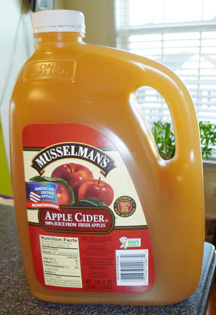I've just recently started my first batch of home-brewed apple cider/ apple wine! Now before I begin, I'd like to emphasize two points:
I'm using four gallon jugs of Musselman's pasteurized Apple Cider (pictured below), because it was cheap and available, and also because it purports to contain only apple juice and ascorbic acid for preservation.

To that, I've added 4 pounds (about 9 cups) of granulated white sugar, and then a single packet (1/4 oz, I guess?) of Fleischmann's ActiveDry yeast (pictured below).

I'm storing all of this in a 5-gallon plastic water jug (I guess they're called carboys), and for a lock I've thrown together something simple:

It's basically just 4 paper towels folded over each other, held snug beneath the lip by a twisted rubber band and some duct tape just to keep it pressed up against the neck.

I put a mug over that, which fits fairly snug as well, so that air can definitely escape but absolutely nothing's getting inside (except more air, obviously, but as long as there's positive pressure in the container that still shouldn't happen!)
So far, it's been brewing for about 48 hours or so. At the 18-hour mark, I noticed a light apple-sulfur smell, and after some research I was glad to find out that's normal. It got a little more intense over the following 12 hours, but either it's not that bad or I've just gotten used to it. I -think- I can smell alcohol already when I get in close, but that might be my imagination.
Anyway, I have a few questions for the community:
Thanks for your input!
- This is my very first batch, and if I've messed anything up then that's pretty okay.
- One of my chief goals in this is to spend as little as possible producing this first batch, so I don't have a lot of the equipment necessary for proper brewing.
I'm using four gallon jugs of Musselman's pasteurized Apple Cider (pictured below), because it was cheap and available, and also because it purports to contain only apple juice and ascorbic acid for preservation.

To that, I've added 4 pounds (about 9 cups) of granulated white sugar, and then a single packet (1/4 oz, I guess?) of Fleischmann's ActiveDry yeast (pictured below).

I'm storing all of this in a 5-gallon plastic water jug (I guess they're called carboys), and for a lock I've thrown together something simple:

It's basically just 4 paper towels folded over each other, held snug beneath the lip by a twisted rubber band and some duct tape just to keep it pressed up against the neck.

I put a mug over that, which fits fairly snug as well, so that air can definitely escape but absolutely nothing's getting inside (except more air, obviously, but as long as there's positive pressure in the container that still shouldn't happen!)
So far, it's been brewing for about 48 hours or so. At the 18-hour mark, I noticed a light apple-sulfur smell, and after some research I was glad to find out that's normal. It got a little more intense over the following 12 hours, but either it's not that bad or I've just gotten used to it. I -think- I can smell alcohol already when I get in close, but that might be my imagination.
Anyway, I have a few questions for the community:
- What timeline should I expect here, in terms of fermentation? I have no way of testing the alcohol levels myself, but I'd love to hear some general estimates based on similar setups.
- Failing that, when will it reach maximum potency and is there a way I'll be able to tell? From what I could find, the alcohol tolerance for the yeast I'm using is 12-13%, and I'm sure I used enough sugar to get to that point, but how long might that take?
- What equipment do I absolutely need, next time I try to do this? For instance, I'm happy using this cheap lock substitution, but if it's going to present massive problems, I might get something more professional.
Thanks for your input!




